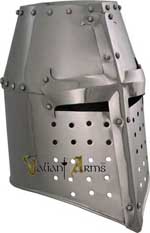Great Helm
Great Helm
 The first original design of the great helm was a cylinder with a flat top. The helm was sufficiently large to be put on easily over the chainmail coif and of such height that it reached down almost, if not quite, far enough to rest on the shoulders. Two plates or bars of iron were fixed on the front, forming a cross; above the transverse bar, openings called vues or sights, were pierced for vision, and holes were drilled lower down for breathing. This ponderous head-piece, which was carried suspended by a small chain from the saddle-bow (according to M. Lacombe "it must have looked like a traveling kettle") and was assumed by the knight only when going into action. In later years, the helm evolved to have
a so called “sugar loaf” shape with rounded and pointed top of the helmet. This shape much more
easily deflected sword blows. The great helm featured small eye and ventilation openings that were
functional and as well decorative. The small openings decreased visibility for the knight wearing
the helm. Also, the ventilation was limited and made breathing difficult. The great helm was used
between 12th and 14th Century. Great helms were used during the Crusades. The great helm was later replaced by the bascinet type helmet.
The first original design of the great helm was a cylinder with a flat top. The helm was sufficiently large to be put on easily over the chainmail coif and of such height that it reached down almost, if not quite, far enough to rest on the shoulders. Two plates or bars of iron were fixed on the front, forming a cross; above the transverse bar, openings called vues or sights, were pierced for vision, and holes were drilled lower down for breathing. This ponderous head-piece, which was carried suspended by a small chain from the saddle-bow (according to M. Lacombe "it must have looked like a traveling kettle") and was assumed by the knight only when going into action. In later years, the helm evolved to have
a so called “sugar loaf” shape with rounded and pointed top of the helmet. This shape much more
easily deflected sword blows. The great helm featured small eye and ventilation openings that were
functional and as well decorative. The small openings decreased visibility for the knight wearing
the helm. Also, the ventilation was limited and made breathing difficult. The great helm was used
between 12th and 14th Century. Great helms were used during the Crusades. The great helm was later replaced by the bascinet type helmet.



